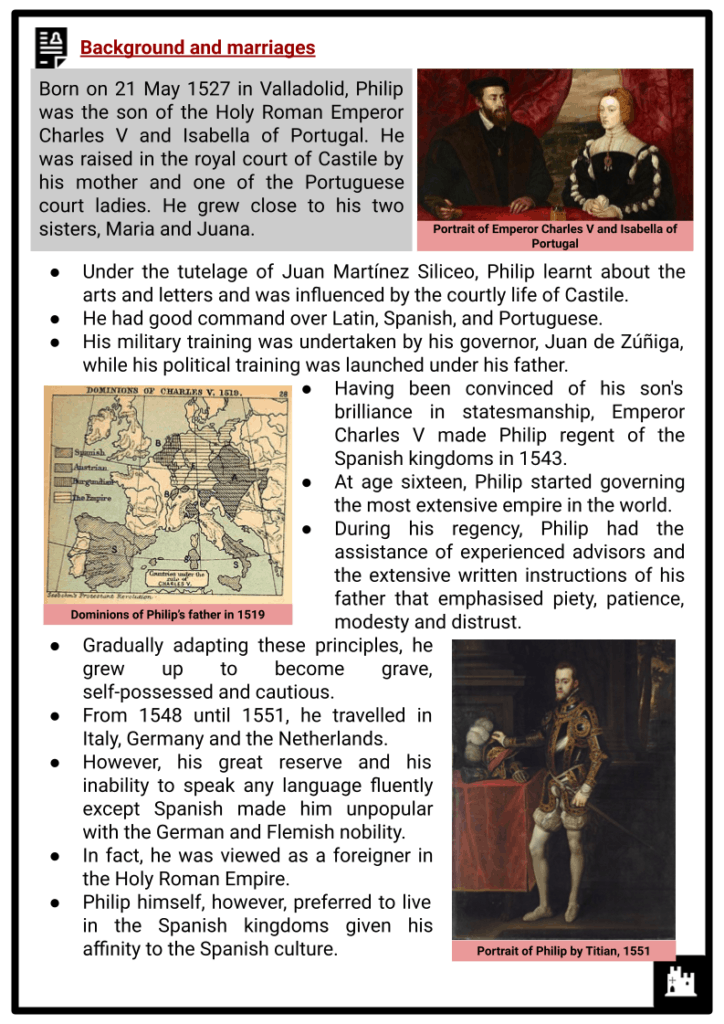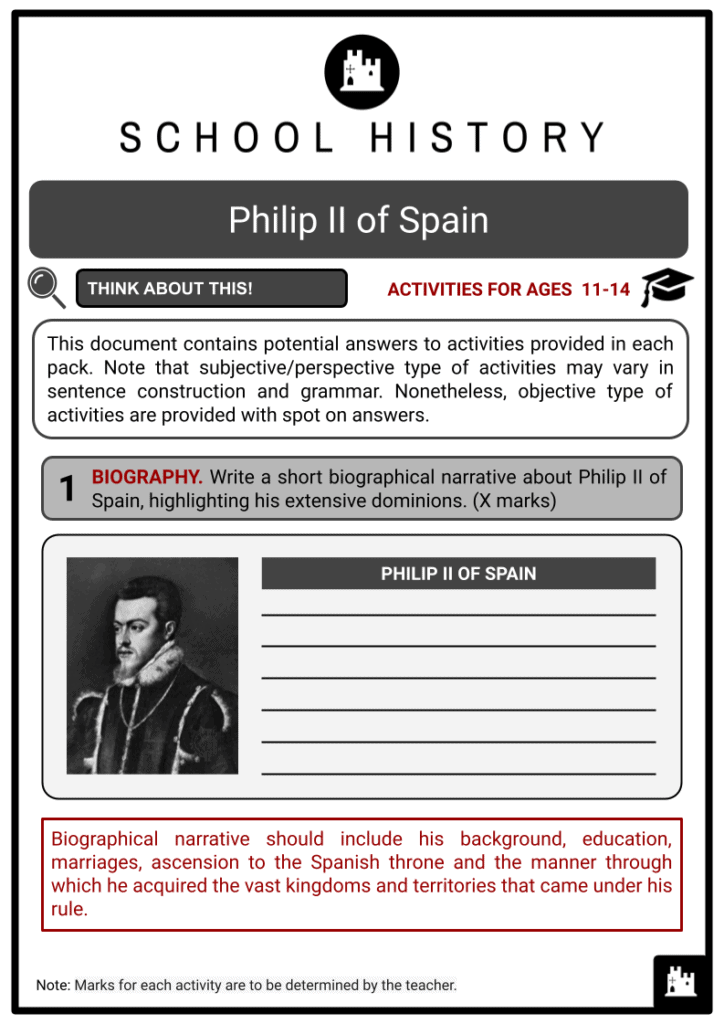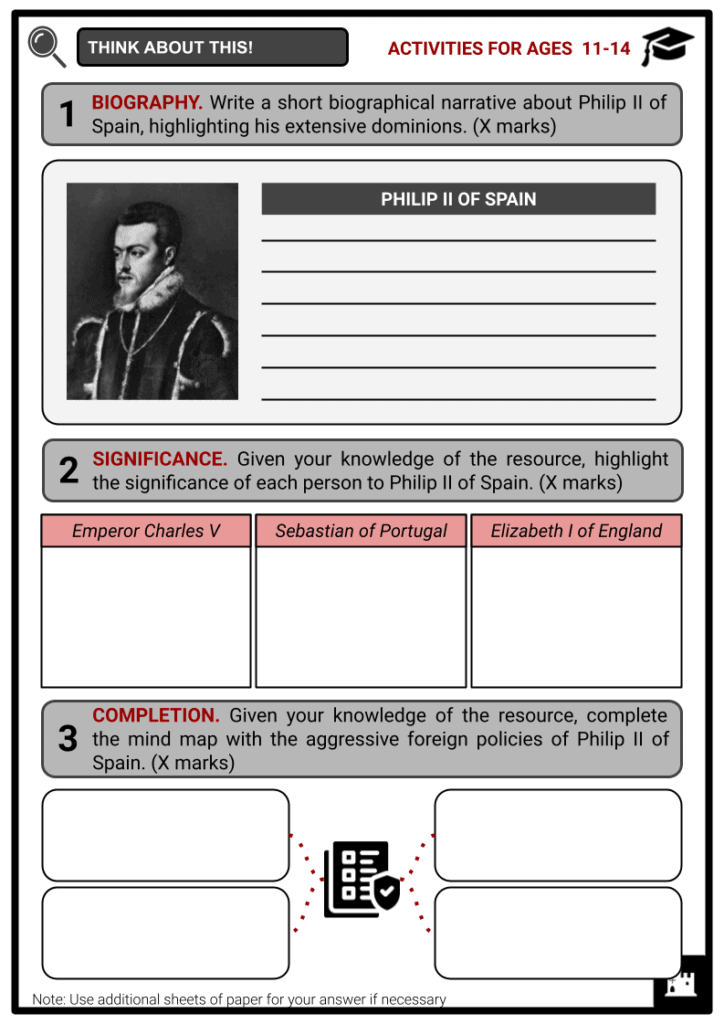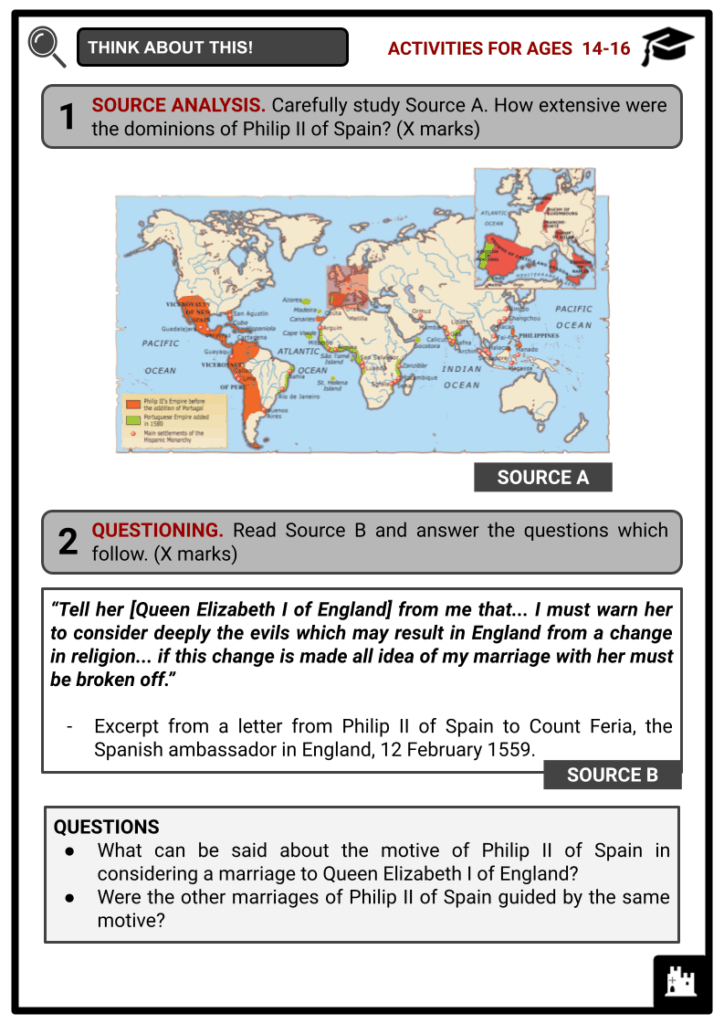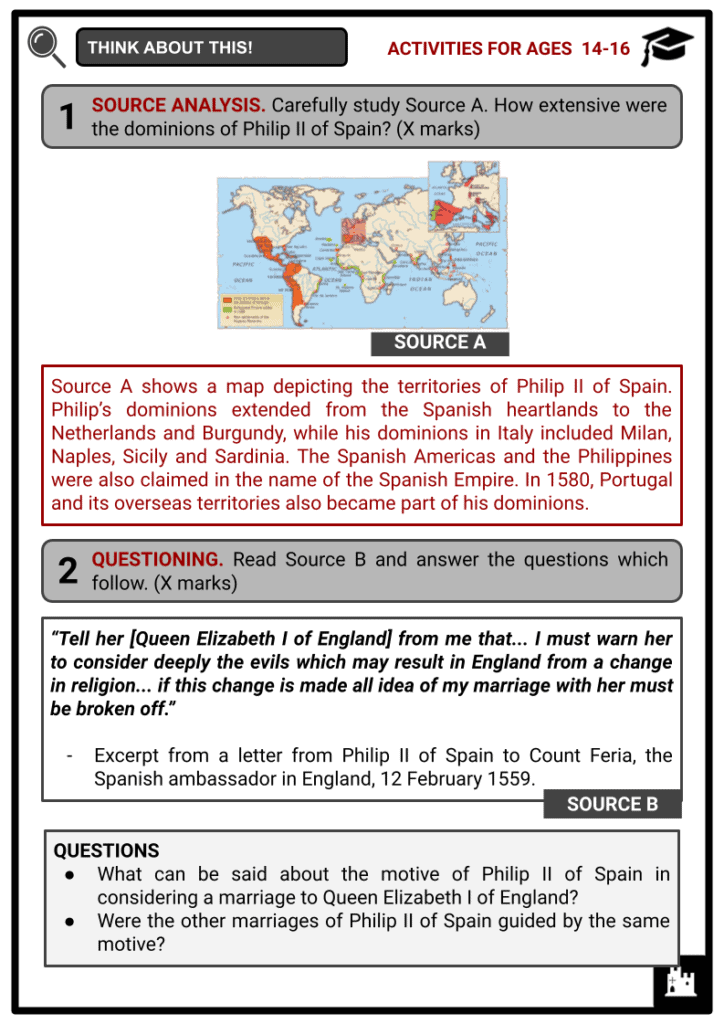Download Philip II of Spain Worksheets
Do you want to save dozens of hours in time? Get your evenings and weekends back? Be able to teach Philip II of Spain to your students?
Our worksheet bundle includes a fact file and printable worksheets and student activities. Perfect for both the classroom and homeschooling!
Table of Contents
Add a header to begin generating the table of contents
Summary
- Background and marriages
- Reign as King of Spain
- Foreign and colonial policies of Philip II
Key Facts And Information
Let’s find out more about Philip II of Spain!
- Philip II of Spain inherited the Spanish Empire from his father Emperor Charles V in 1556. Under his rule, Spain reached its greatest power, extent and influence, known as the Spanish Golden Age. He successfully secured the Portuguese kingdom and empire in 1580 following Portugal’s succession crisis. His devotion to Catholicism and passion for the greatness of Spain came to be the basis of his relations with other nations.
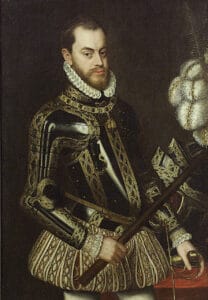
- Considering himself as the defender of Catholic Europe, Philip II employed aggressive policies against the Ottoman Empire in the Mediterranean and the Protestant Reformation in the Netherlands, England and France. In fact, he attempted to invade Protestant England with his Invincible Armada in 1588. In 1598, he was succeeded by Philip III, his son from his fourth marriage.
Background and Marriages
- Born on 21 May 1527 in Valladolid, Philip was the son of the Holy Roman Emperor Charles V and Isabella of Portugal. He was raised in the royal court of Castile by his mother and one of the Portuguese court ladies. He grew close to his two sisters, Maria and Juana.
- Under the tutelage of Juan Martínez Siliceo, Philip learnt about the arts and letters and was influenced by the courtly life of Castile.
- He had good command over Latin, Spanish, and Portuguese.
- His military training was undertaken by his governor, Juan de Zúñiga, while his political training was launched under his father.
- Having been convinced of his son's brilliance in statesmanship, Emperor Charles V made Philip regent of the Spanish kingdoms in 1543.
- At age sixteen, Philip started governing the most extensive empire in the world.
- During his regency, Philip had the assistance of experienced advisors and the extensive written instructions of his father that emphasised piety, patience, modesty and distrust.
- Gradually adapting these principles, he grew up to become grave, self-possessed and cautious.
- From 1548 until 1551, he travelled in Italy, Germany and the Netherlands.
- However, his great reserve and his inability to speak any language fluently except Spanish made him unpopular with the German and Flemish nobility.
- In fact, he was viewed as a foreigner in the Holy Roman Empire.
- Philip himself, however, preferred to live in the Spanish kingdoms given his affinity to the Spanish culture.
Princess Maria Manuela of Portugal
- Philip’s first marriage was to his cousin Princess Maria Manuela of Portugal in 1543.
- She bore him a son, Don Carlos, on 8 July 1545.
- Unfortunately, she died four days later due to haemorrhage.
Queen Mary I of England
- His second marriage was to his cousin once removed, Queen Mary I of England, in 1554, as he was seeking an alliance with England.
- Under the terms of this marriage, he became king consort of England until the queen's death.
- As an ardent defender of Catholicism, he fought against the progress of the Reformation in England, where his queen, who shared his faith, severely repressed the Protestants.
- Their marriage was unpopular in England.
- In 1556, he succeeded to the Spanish throne after his father's abdication, but he would only move to the country two years later.
- When Mary I died childless in November 1558, Philip considered marrying Mary I's Protestant sister and heir to the English throne, Queen Elizabeth I. However, this plan never materialised.
Princess Elizabeth of Valois
- His third marriage was to Princess Elizabeth of Valois, daughter of Henry II of France, in 1559, as the result of the Peace of Cateau-Cambrésis.
- This political alliance ended the open wars between Spain and France for a generation. Elizabeth bore Philip two daughters, Isabella Clara Eugenia and Catherine Micaela.
- She died in 1568, a year after giving birth to her second child.
- This marriage gave Philip a claim to the French throne on behalf of his daughter Isabella.
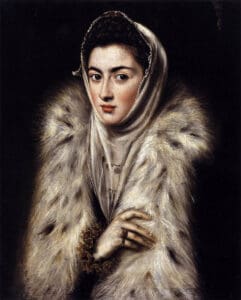
Anna of Austria
- His final marriage was to Anna of Austria, daughter of his first cousin Emperor Maximilian II.
- She only had one surviving son, Philip III.
- She died in 1580.
Reign as King of Spain
- As heir to the Spanish kingdoms and empire, Philip carried several titles. In 1540, he received the Duchy of Milan from his father and in 1554, the Kingdoms of Naples and Sicily on the occasion of his marriage to Mary I of England. His father resigned the Netherlands in 1555, and abdicated as ruler of Spain and its overseas empire in 1556, all in favour of Philip. He was crowned Philip II of Spain in 1556. However, the imperial title of the Holy Roman Empire went to his uncle Ferdinand I.
- In the first years of his reign, Philip continued the war with France, winning at the Battle of Saint-Quentin in 1557. Unfortunately, he did not know how to profile this success.
- After catching sight of the battlefield, he now held a permanent distaste for war.
- He returned to Spain from the Netherlands in 1559 and from then on, he never left the Iberian Peninsula again.
- In 1561, he moved his court to the Castilian stronghold of Madrid, effectively making it the capital of Spain.
- Furthermore, around this time, he converted the Royal Alcázar of Madrid into a royal palace, commissioning tradesmen from the Netherlands, Italy, and France.
- Philip set up his residence in Spain and built the monastic palace at El Escorial, where he shut himself up thereafter.
- This palace was created as a monument to Spain's role as a centre of the Christian world.
- From his palace, he directed the affairs of his immense empire through his personal control of official appointments and all forms of patronage.
- Since he was never seen by his subjects outside Castile, they gradually turned not only against his ministers but also against him.
- Apart from the economic troubles in the form of a huge debt that he inherited from his father, Philip was faced with a difficulty to rule the Spanish kingdoms and its possessions, given the various assemblies he was subjected to.
- Unlike France that had a single Estates-General, his domains lacked a supreme assembly, thus power was placed in his hands.
- To manage these challenges, authority was directed by local agents appointed by the crown and viceroys carrying out crown instructions.
- With a passion for absolutism, Philip personally presided over specialised councils for state affairs, finance, war, and the Inquisition.
- Under Philip's reign, all work was done on paper, on the basis of consultas, that is, memoranda, reports, and advice presented him by his ministers.
- Having a very high idea of his duty, he weighed and ripened his decisions with so much awareness that they were often delivered too late; he showed nonetheless inflexible obstinacy in execution.
- Without being mean, he was capable of cruelty and distrust, of which even his most faithful servants had suffered disgrace.
- Consequently, his court became notorious for the hostility of its faction rivalries, and in turn, impacted the character of the whole Spanish system of government.
- It was in Philip's reign that the Spanish Golden Age began. Spanish culture flourished, forming a lasting legacy in literature, music, and the visual arts.
- Sofonisba Anguissola was one of the notable artists from Philip's court, who served as an attendant to Princess Isabella Clara Eugenia and then as a court painter for the queen, Elizabeth of Valois.
- During her time as a court painter, Anguissola created many official portraits of the royal family.
- Shut up in the most obtuse religiosity, Philip brought into the struggle against heresy a still sharper passion and a closer fanaticism than his father.
- He was as passionate for the greatness of Spain as for the triumph of the Catholic faith. It was through Spain that he dreamed of operating the restoration of Catholicism.
- As a result, his views as to what was the service of God and what was the service of the Spanish monarchy became difficult sometimes to distinguish.
Foreign and colonial policies of Philip II
- When Philip ascended the Spanish throne, his dominions were extensive and grew to include more territories throughout his reign. He pursued peace with his neighbours in Western Europe for the first 20 years of his reign, but this gradually changed from the 1570s. On the contrary, he sought varying foreign policy toward other nations.
- In 1558, Philip's appeal to the Pope and other European powers to prevent the rising Ottomans proved fruitless.
- In 1560, he then organised a Holy League between the Spanish kingdoms and the Republic of Venice, the Republic of Genoa, the Papal States, the Duchy of Savoy and the Knights of Malta, commencing a major naval war with the Ottoman Empire.
- The increasing Ottoman domination in the Mediterranean was reversed at the Battle of Lepanto in 1571.
- The Holy League under the command of Philip's half-brother, John of Austria, decisively destroyed nearly the entire Ottoman fleet.
- Whilst the Ottomans were able to rebuild their fleet and won against the Holy League in 1574, their defeat at Lepanto permanently reversed the balance of naval power in the Mediterranean and ended the threat of Ottoman control.
- A peace treaty with Ottomans was signed in 1585.
- In the early 1560s, Philip sent out Miguel López de Legazpi to a Spanish colony in the western Pacific Ocean, the Philippines, to establish permanent settlements there.
- The Philippines was claimed as a colony of the Spanish Empire in 1521.
- It was named after Philip, who was Prince of Asturias at the time, during the expedition of Ruy López de Villalobos in 1543.
- Initial expeditions that were dispatched by Philip ended in disaster.
- Finally, in 1565, Legazpi successfully founded the first permanent Spanish settlement in Cebu.
- This was followed by the creation of the first trans-Pacific trade route between America and Asia by exploiting the natives of the Philippines.
- The evangelisation of the Philippines began afterwards.
- Philip encountered many difficulties in the Seventeen Provinces collectively known as the Netherlands.
- From 1568, the Netherlands was troubled with open warfare and rebellions against Philip's taxation demands and the continuous persecution of Protestants.
- Under the governorate of Fernando Álvarez de Toledo, Duke of Alba, who instituted the Council of Troubles, many Protestants were executed, in addition to the far greater number he massacred during the war.
- Toledo was then replaced by Luis de Requesens in 1573.
- In 1578, Alexander Farnese, Duke of Parma, took over as Governor-General of the Netherlands and captured many rebel towns in the south.
- In 1581, the northern provinces condemned Philip as their king while the southern Netherlands remained under Spanish rule.
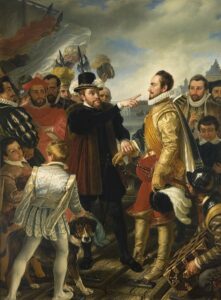
- In 1584, Philip had offered a reward to anyone who would assassinate the main leader of the Dutch Revolt, William the Silent.
- William's death did not stop the Dutch forces to continue their fight and use their substantial naval resources to plunder Spanish ships and blockade the Spanish-controlled southern provinces.
- Northern Netherlands remained Protestant and unconquered.
- In 1578, Philip's nephew, King Sebastian of Portugal, died heirless, causing a succession crisis.
- This provided an opportunity for Philip’s succession to Portugal.
- With the support of the high clergy and nobility, Philip successfully conquered Portugal in 1580 and was crowned as Philip I of Portugal.
- This granted him control of the extensive Portuguese empire.
- He left for Madrid in 1583 and appointed his nephew Albert of Austria as his viceroy in Lisbon.
- He ruled the Portuguese empire from Madrid, allowing Portugal to maintain autonomous law, currency, and government.
- In 1581, Philip sent an expedition to fortify the Strait of Magellan against the English raids on the Spanish colonies.
- The Strait of Magellan was considered an important passage for it was the only known entrance from the Atlantic.
- The Spanish viceroy Francisco de Toledo commissioned Pedro Sarmiento de Gamboa to explore the strait and establish settlements there.
- The expedition landed in 1584 and founded the colonies known as Nombre de Jesús and Ciudad del Rey Don Felipe.
- However, these colonies failed to survive and all the settlers were believed to have perished due to famine.
- From the 1580s, both England and France gave modest assistance to the rebellious provinces of the Netherlands.
- This led Philip to change his policy towards the two nations.
- Philip was eventually convinced to begin an open intervention against England and France to assert his own authority in the Netherlands and to save the Catholic faith in Western Europe.
- With these aims, he started the construction of the Armada as early as 1584.
- He sought to conquer Protestant England and overthrow Queen Elizabeth I in 1588, with the help of the Spanish Army in the Netherlands.
- However, a storm destroyed the Invincible Armada, leading to a Spanish defeat.
- In France, Philip sent money and troops to support the Holy League against Henry of Navarre and the Huguenots.
- His dream of seizing the French throne for his daughter Isabella failed and ended with the Peace of Vervins in 1598.
- Despite these losses, his intervention in France contributed to Henry IV's conversion to the Catholic faith.
- Spain was still at the height of its power when Philip died in El Escorial on 13 September 1598. He was succeeded by his 20-year-old son, Philip III.


